The best electric guitars of all time
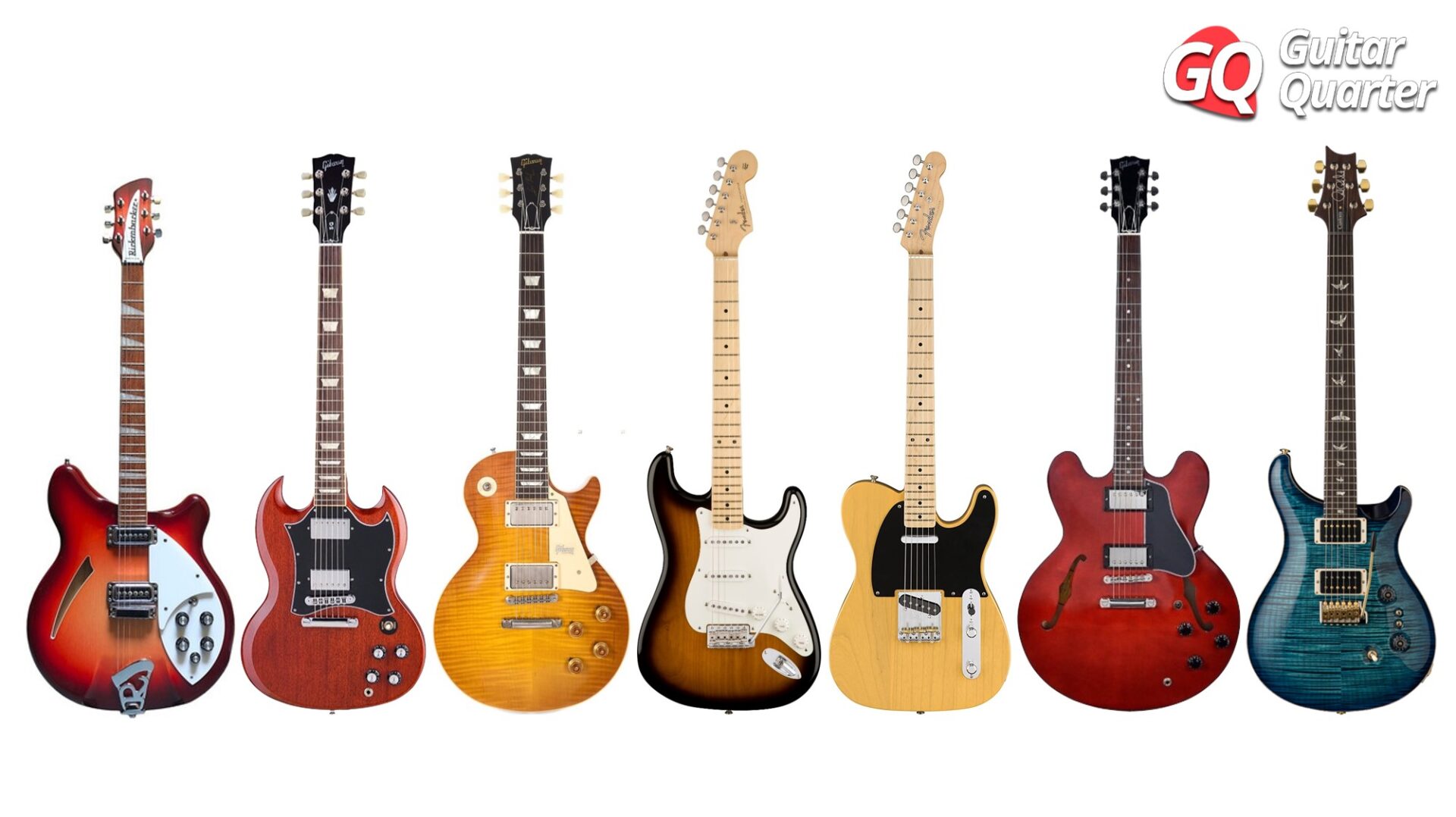
The best electric guitars of all time, from the Fender Stratocaster to the Gibson Les Paul, their specs, features, and history.
Table of Contents
Best electric guitar ever made
While it is true that there is a guitar for every guitarist, there are models of electric guitars that most guitarists have or want. Thus, we can find the best electric guitars in history. The electric guitars that every collection must have.
We review the best guitars of all time that over the years do not lose their validity. Thus, over the years, there are models of electric guitars that have stood out above the rest. The most popular guitars in the world, which practically every guitarist has or wants. These guitars are the ones that defined the history of music and especially Rock. Among our choice we choose mass-produced models, we do not include Custom or unique models such as Brian May’s Red Special.
In this article, we show you the 20 best electric guitars of all time. In addition, we mention another 8 emblematic guitars, totaling the 28 most popular guitars in history.

What criteria do we use to choose the best guitars of all time?
To select the great electric guitars in history, we considered the following criteria:
- Sales and popularity
- Distinctive tone and build quality
- Influence and legacy: contribution to music, famous guitarists who played them, their use to make records, etc.
Although the selection and its order can be subjective, we try to do it on an objective basis based on the previous points. Please tell us which guitar you think is the best of all time in the comments section.
List of the best electric guitars of all time
- Fender Stratocaster
- Gibson Les Paul
- Fender Telecaster
- Gibson SG
- Gibson ES-335
- PRS Custom 24
- Gretsch White Falcon 6136
- Rickenbacker 360
- Jackson Soloist
- Fender Jazzmaster
- Epiphone Casino
- Gibson Flying V
- Fender Jaguar
- Jackson Rhoads
- Kramer Baretta
- Gibson Explorer
- Gretsch 6120
- Yamaha SG-2000
- Ibanez JEM
- Gibson Firebird
1) Fender Stratocaster

Although it pains many Gibson fans, the Fender Stratocaster is the best guitar of all time in our opinion. This is because since its release in 1954, it has been used by countless guitarists in all genres of music. In addition, it revolutionized the design and functionalities of the instrument, becoming the best-selling and most copied guitar of all time.
In addition to the different copies made by the different brands, the Strat also served as a platform for other guitar models such as EVH Wolfgang, Jackson, ESP, Ibanez superstrats, among others.
There are also many guitarists who consider a Stratocaster with the HSS pickup configuration, that is, a Humbucker in the bridge and two singlecoils in the middle and neck positions, the most versatile guitar there can be.
As we said before, the Stratocaster was a very innovative guitar that with its new features revolutionized the electric guitar industry. Thus, its double cutaway design and belly cut and forearm contour made it the most ergonomic guitar by scandal. In addition, its three selectable pickups and the synchronized tremolo system gave it a versatility of sounds and uses never seen before. Over the years, the Stratocaster has remained virtually unchanged in its classic model, but variations adapted to new musical styles such as Superstrats have been released.
Advantages of the Fender Stratocaster
- Versatility of audios and use
- Ergonomic
- Highly customizable
Disadvantages of the Fender Stratocaster
- For some they can become very bright and with few mid frequencies
Typical Fender Stratocaster Specs
- Body: Alder or Ash are the most traditional tonewoods
- Body Type: Solid
- Neck: Maple bolted to the body
- Fretboard: Rosewood or maple
- Scale: 25.5″
- Pickups: Three Singlecoils
- Electronics: one volume control, 2 tone controls, 5-way switch
- Bridge: Fender Synchronized Tremolo
We recommend you visit our guide to the best years of the Fender Stratocaster.

Famous Fender Stratocaster Guitarists
It’s hard to find guitarists who haven’t played it; but there are guitarists for whom the Stratocaster is their only or main guitar, here we include those who have the Stratocaster as their main guitar.
- Eric Clapton
- Jimi Hendrix
- Stevie Ray Vaughan
- Yngwie Malmsteen
- Buddy Holly
- Jeff Beck
- David Gilmour
- Eric Johnson
- Ritchie Blackmore
- Buddy Guy
- Hank Marvin
- Mark Knopfler
- Richie Zambora
2) Gibson Les Paul

The Les Paul was Gibson’s answer to the appearance of the first solid body electric guitar, the Fender Telecaster. Released in 1952, the Gibson Les Paul is one of the greatest guitars of all time. Its main characteristic is its thick and fat tone, with a lot of sustain. The Les Paul is the most iconic guitar from Gibson, the oldest and most traditional guitar manufacturer in the world.
This guitar was designed to differ from the Fender Telecaster, which has brighter, sharper tone. For this reason, both the neck and the body are made of mahogany, tonewood with a predominance of mids frequencies. That’s why the maple top is added to give it high frequencies and definition. Plus, it was designed to be more sophisticated, so an arched top was included, something Ted McCarty from Gibson knew Fender couldn’t copy.
Les Paul was a booming Jazz guitarist of the time, who had proposed to Gibson years before to make solid body guitars, which was rejected as absurd by the Company’s management. It was only when Fender began marketing the Telecaster that Gibson, led by Ted McCarty, designed a solid-body electric guitar, and went to the artist to name it after him.
Although we all appreciate the Gibson Les Paul very much today, back then, the guitar was not successful. So much so, that between 1961 and 1968, Gibson Les Pauls were not manufactured. In 1960, the Les Paul was replaced by the Gibson SG, and it was only in 1969 that with two reissues this emblematic model was released again. This is one of the reason why, although it is a great guitar, we put it below the Fender Stratocaster.
Advantages of the Gibson Les Paul
- Unique fat and deep tone
- Excellent sustain
- Great for heavy tones
Disadvantages of the Gibson Les Paul
- Expensive
- For many they are not comfortable and can be very heavy
- Not as versatile as other guitars
Typical Gibson Les Paul Specs
- Body: Mahogany with maple top
- Body Type: Solid, but could include weight-reliefs
- Neck: Mahogany set-in
- Fretboard: Rosewood or ebony
- Scale: 24.75″
- Pickups: Two Humbuckers
- Electronics: Two volume controls, 2 tone controls, 3-way switch
- Bridge: Tune-o-Matic with stopbar tailpiece
Also, we suggest you visit our guide to the best years of the Gibson Les Paul.

Famous Gibson Les Paul Guitarists
- Jimmy Page – Led Zeppelin
- Slash – Guns ‘N Roses
- Les Paul
- Gary Moore
- Peter Green
- Randy Rhoads – Ozzy Osbourne
- Billy Gibbons
- Frank Zappa
- Alex Lifeson – Rush
- Chuck Berry
- Ace Frehley
- Joe Bonamassa
- Neal Schon
- Zak Wylde – Ozzy Osbourne
3) Fender Telecaster

The Fender Telecaster is the first mass marketed solid body electric guitar. Although the first guitar was the version of a single pickup in the bridge with the name of Fender Esquire. The Telecaster was later released under the Broadcaster name, but due to a branding issue, it was later changed to the Telecaster.
Leo Fender’s concept was to make a simple, cheap but good work guitar. Thus, the concept was to keep costs as low as possible but with a quality product. Thus, the design consists of a neck made of a single piece of wood screwed to the body, when they were normally glued. The body is straight without cuts or contour. For the tonewoods Leo Fender opted for maple for the neck due to its hardness and for the body he used mainly pine, ash and alder. All abundant and relatively cheap woods.
Like the Stratocaster, its simple yet effective design has changed little to nothing since its launch. Only countless variants have been designed, either with Wide Range pickups or PAF-type Humbuckers, hollowed -Thinline-, with belly cuts and/or forearm contour, among many other modifications.
The Tele is considered one of the best electric guitars for country music, and also great for rock and blues. However, it is one of the super versatile guitars.
Thus, while the Stratocaster was the revolution of solid body electric guitars, the Telecaster was the one that forever changed the history of music. Without a doubt, the Fender Telecaster is the third best solid guitar of all time.
Advantages of the Fender Telecaster
- Versatility of audios and use
- Highly customizable
Disadvantages of the Fender Telecaster
- For some they can become very bright
- It is not the most ergonomic guitar
Typical Fender Telecaster Specs
- Body: Ash or Alder
- Body Type: Solid
- Neck: Maple
- Fretboard: Rosewood or maple
- Scale: 25.5″
- Pickups: two single coils
- Electronics: 1 volume control, 1 tone control, 3-way switch
- Bridge: Tele bridge plate with 3 or 6 saddles
Also, we suggest you visit our article on the best years of the Fender Telecaster.

Famous Fender Telecaster Guitarists
- Keith Richards – The Rolling Stones
- John 5
- Brad Paisley
- Richie Kotzen
- Bruce Springteen
- Jimmy Page (early years) – Led Zeppelin
- Tom Morello – Prophets of Rage, Rage Against the Machine and Audioslave
- Merle Haggard
- Jerry Donahue
- Muddy Waters
- Albert Lee
- Albert Collings
4) Gibson SG
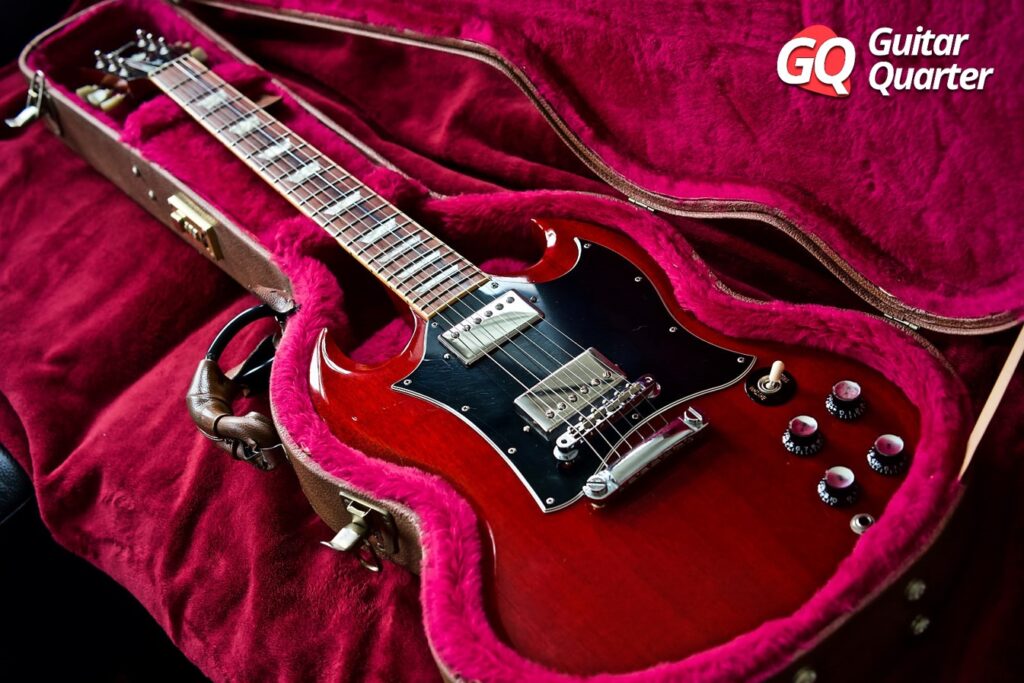
The Gibson SG is the brand’s best-selling guitar. The model was released as a replacement for the Gibson Les Paul in the late 1960s, and has been in continuous production ever since. Originally, given the decline in sales of the Les Paul due to its high cost and weight, compared to Fender guitars, Gibson designed the SG to compete with the Stratocaster. Thus, it was designed with double cutaway, better access to the high frets and a thinner only mahogany body of 1 3/8″ inches / 35 mm vs. the Les Paul of around 2.244 inches / 57 mm.
Initially it came out under the name of Les Paul, but two years later the contract with the artist expired. At that time, Les Paul was in the middle of a divorce trial, so he did not renew until his legal situation was resolved. Thus, from 1962, the SG takes its current name from the initials of Solid Guitar.
The SG is a guitar with predominantly mid-frequency audio just like the Les Paul, but with less fat audio due to its thinner body and the neck joint that is on the 19th fret instead of the 16th of the Les Paul. The Gibson SG is a rock machine.
Advantages of the Gibson SG
- Gibson’s warm midrange focused tone
- Light
- Excellent access to the high frets
Disadvantages of the Gibson SG
- Not so versatile as other guitars
- For some guitarists the tone may lack treble and definition
Gibson SG Specifications
- Body: Mahogany
- Body Type: Solid
- Neck: Mahogany set-in to the body
- Fretboard: Rosewood
- Scale: 24.75″
- Pickups: Two Humbuckers
- Electronics: two volume controls, two tone controls, 3-way switch
- Bridge: Tune-o-Matic with Stopbar tailpiece
Don’t miss our guide to the best years of the Gibson SG.

Famous Gibson SG Guitarists
- Angus Young – AC DC
- Tony Iommi – Black Sabbath
- Derek Trucks
- Pete Townshend – The Who
- Frank Zappa
- Eric Clapton (early years)
- Frank Marino
- George Harrison – The Beatles
- Robbie Krieger
5) Gibson ES-335
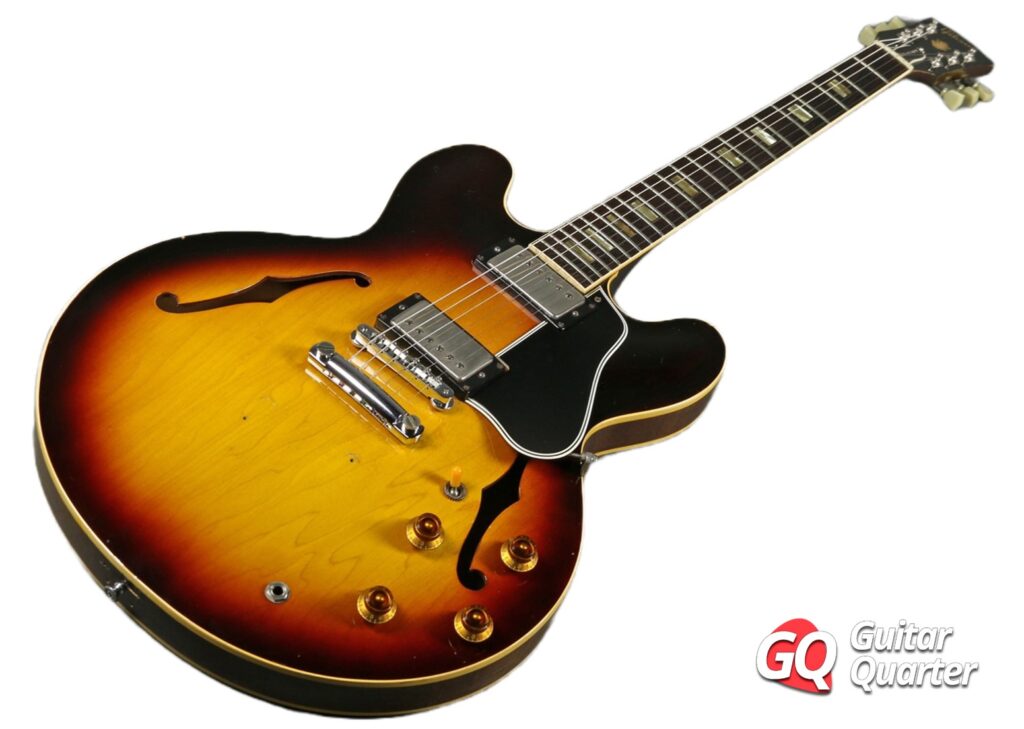
The ES-335 was designed to appeal to traditional players who were reluctant to enter the new world of solid guitars. Thus, a semi-hollow body guitar was designed, that is, a hollow body but with a solid central block to avoid feedback. If you want to know more about types of guitars: characteristics and differences, don’t miss our tutorial.
Its name ES comes from Electric Spanish. Its sound is also acoustic, a middle ground between a traditional soundboard guitar and a solid body. It is a very versatile guitar with an airy and woody tone.
A variation of the ES-335, the ES-355 can be seen immortalized in the movie Back to the Future when Marty McFly plays Johnny B. Goode.
Without a doubt, the Gibson ES-335 is one of the best electric guitars of all time.
Advantages of the Gibson ES-335
- Mid and warm Gibson tone
- Excellent access to the high frets
- Versatility of use with classic tone
Disadvantages of the Gibson ES-335
- For heavy styles can generate feedback
- For some guitarists the tone may lack treble
Specifications of the Gibson ES-335 and its variants
- Body: Maple and Poplar
- Body Type: Semi-Hollow
- Neck: Mahogany or Maple set-in
- Fretboard: Rosewood for the ES-335 or Ebony for the ES-355
- Scale: 24.75″
- Pickups: Two Humbuckers
- Electronics: two volume controls, two tone controls, 3-way switch
- Bridge: Tune-o-Matic with Stopbar tailpiece

Famous Gibson ES-335 guitarists and its variants
- Chuck Berry
- BB King
- Larry Carlton
- Alvin Lee
- Freddie King
- Noel Gallagher
- Ritchie Blackmore
- Dave Grohl
- Joe Bonamassa
- John Scofield
- Alex Lifeson
6) PRS Custom 24

PRS established in 1985, founded by luthier Paul Reed Smith has become one of the most important American guitar manufacturers. Noted for its supreme quality, impeccable design, and extravagant colors, PRS has earned its place between Fender and Gibson. The PRS Custom 24 is the flagship of the brand, with a design halfway between a Fender Stratocaster and a Gibson Les Paul.
The double horn body more similar to the Stratocaster, but made in mahogany with a curved maple top similar to the Les Paul, although with a thickness more similar to the SG. The scale is neither the 25.5″ generally used by Fender, nor the 24.75″ generally used by Gibson, it is somewhere in between with 25″. The neck is made of mahogany and rosewood like the Gibson guitars. The pickups are two Humbuckers with a brighter tone than the Gibson ones, which makes their guitars sound quite similar to a Superstrat despite the Gibson-style tonewoods used for their construction.
Thus, the excellent woods used such as the superb flamed tops, the impressive colors, the iconic bird-shaped inlays, and the impeccable quality of construction stand out. With a unique personality all its own, while PRS guitars fall somewhere between Fender and Gibson, PRS sound like PRS. Without a doubt, this is one of the best electric guitars of all time.
Check out our pick of the best easy guitar songs for beginners.
Advantages of the PRS Custom 24
- Extreme comfort and playability
- Superlative quality
- Super showy
Disadvantages of the PRS Custom 24
- Extremely expensive -although they are worth every penny of their price-
- For lovers of vintage audio they can be a bit modern.
PRS Custom 24 Specifications
- Body: Mahogany with maple top
- Body Type: Solid
- Neck: Mahogany set-in
- Fretboard: Rosewood
- Scale: 25″
- Pickups: Two Humbuckers
- Electronics: one volume control, one tone control, 5-way switch
- Bridge: PRS Tremolo bridge

Famous PRS Guitarists
- Carlos Santana
- Mark Tremonti
- John Mayer
- Alex Lifeson – Rush
- Al Di Meola
- David Grissom
- Howard Leese
7) Gretsch White Falcon 6136

The Gretsch White Falcon was released in 1954 and was a favorite of Country, Rockabilly and Rock and Roll guitarists. This guitar is hollow body with DeArmond Dynasonic single coil pickups. It was originally designed as a prototype display guitar for trade shows and was billed as “the Guitar of the Future”. But as a result of the large number of orders, it began to be manufactured and marketed. It may be the most beautiful guitar Gretsch has ever made.
Unlike the Gretsch 6120, the White Falcon has a 25.5″ long scale, instead of the 6120’s 24.6″. Also, the bodies are similar, but not the same, with the Falcon being slightly larger with 17″ vs. the 16″ of the 6120. This makes the Gretsch White Falcon 6136 have more attack, twang, brightness and also bass.
You may be interested in our Guitar Sizes for Kids, Teens, and Adults tutorial.
Currently, the White Falcon is sold in values that vary according to its version, in its Standard lines they are between USD 3,600 and USD 4,200 and the Custom Shop at USD 9,000.
Advantages of the Gretsch White Falcon 6136
- Unique tone with twang, high, mid and low frequencies
- Unique aesthetic
Disadvantages of the Gretsch White Falcon 6136
- Tends to generate feedback noise
- For some guitarists it can have an excessively sharp tone
Specifications of the Gretsch White Falcon 6136
- Body: Maple
- Body Type: Hollow
- Neck: Maple set-in
- Fretboard: Rosewood
- Scale: 25.5″
- Pickups: Two DeArmond Dynasonic singlecoils until 1958, then two Filter’Tron Humbuckers
- Electronics: two volume controls and one tone control, 3-way switch
- Bridge: Space Control with Cadillac “G” tailpiece
Famous Guitarists of the Gretsch White Falcon 6136
- Billy Duffy
- Neil Young
- Elvis Presley
- Steven Stills
- Martin Gor
- Stephen Stills
- Amy Gore
- Chris Cheney
- John Frusciante
- David Lee
- Michael Guy Chislett
- Joe Strummer
8) Rickenbacker 360

The Rickenbacker 360 guitar is undoubtedly a unique instrument. With his characteristic tone this guitar has been the protagonist of innumerable recordings of the 60’s. Rickenbacker guitars to this day are still made almost by hand as in the early years. Thus, production is limited and they are difficult to obtain. Unfortunately, their prices are also very high and these guitars are only accessible to great artists or collectors.
Also, the Rickenbacker 360 has its twelve-string version, the 360/12. This version has been popularized by George Harrison of the Beatles and Roger McGuinn of the Byrds.
Advantages of the Rickenbacker 360
- Unique tone with twang, high frequencies
- Unique aesthetic
- Handcrafted construction
Disadvantages of the Rickenbacker 360
- For some they can become very bright and with thin audio
- It is not the most ergonomic guitar when it does not have cut
Typical Rickenbacker 360 Specifications
- Body: Maple
- Body Type: Semi-Hollow
- Neck: Maple set-in
- Fretboard: Rosewood or maple
- Scale: 24.75″
- Pickups: Two High Gain Single Coils
- Electronics: two volume controls, two tone controls, and mix control for both pickups and a 3-way switch, two inputs: one mono and the other stereo to have the signal of each pickup separately
- Bridge: fixed with six saddles and “R” tailpiece
Rickenbacker 360 Famous Guitarists
- George Harrison – The Beatles
- John Lennon – The Beatles
- Brian Jones – The Rolling Stones
- Peter Buck – R.E.M.
- Roger McGuinn – The Byrds
- Pete Townshend – The Who
- Steve Howe – Yes
- Johnny Marr – The Smiths
- Paul Kantner – Jefferson Airplane
- Billie Joe Armstrong – Green Day
- Courtney Love – Hole
- James Iha – The Smashing Pumpkins
- Per Gessle – Roxette
- Mike Campbell – Tom Petty and the Heartbreakers
- Tom Petty
- Ed O’Brien – Radiohead
- Carl Wilson – The Beach Boys
- Tony Hicks – The Hollies
9) Jackson Soloist

Jackson Soloist is one of the best Heavy Metal electric guitars of all time. The Soloist is a superstrat that was released in 1984. This Jackson guitar is designed with a neck-tru maple neck. Neck-tru necks run the full length of the guitar, tip to tip, and two wings are added to each side to form the body. This gives the guitar a particular tone with more sustain.
The Jackson Soloist comes in several configurations, but the main and most recognized ones are with HSS and HH pickups, ebony Fretboard, alder body and Floyd Rose floating bridge.
Today there is a wide variety of versions of the Jackson Soloist with differentiated characteristics, the SL1 being the flagship.
Advantages of the Jackson Soloist
- Ideal for Heavy Metal styles
- Ergonomic
- Neck-Tru construction
Disadvantages of the Jackson Soloist
- They can get heavy
- Not ideal for vintage styles
Jackson Soloist Specifications
- Body: Alder and alternatively mahogany, basswood or ash
- Body Type: Solid
- Neck: Maple neck-tru
- Fretboard: Ebony and alternatively rosewood or maple
- Scale: 25.5″
- Pickups: One Humbucker and two singlecoils or two Humbuckers
- Electronics: one volume control, one tone control, 3-way or 5-way switch
- Bridge: Floyd Rose or Kahler tremolo, or String-thru
Famous Jackson Soloist Guitarists
- Gary Moore
- Chris Broderick of Megadeth
- Mick Thomson of Slipknot
- Jeff Loomis of Arch Enemy
- Andreas Kisser from Sepultura
- Derek Miller of Sleigh Bells
- Joey Conception of Armageddon
10) Fender Jazzmaster

The Jazzmaster arrived in 1958 with its rare single-coil pickups for the time. This was a guitar made for Jazz, but it found a home in Rock, particularly Surf music. The Jazzmaster eventually fell out of fashion and in 1977 production was discontinued. Then, in the 90s, it gained prominence again thanks to Alternative Rock and Indie musicians, mainly, and in 1999 its production was resumed.
The Fender Jazzmaster was released with the goal of breaking into the world of Jazz guitarists. This guitar was designed as Fender’s top-of-the-line guitar, above the successful Stratocaster.
The Jazzmaster has a offset body which makes it very ergonomic. In addition, it includes a sophisticated system of controls with two circuits, a darker one for rhythmic styles, and a brighter one for Lead styles. The Jazzmaster pickups have a similar aesthetic to the Gibson P90, but they have a good Fender sound, with a little more output than traditional Fender pickups.
You might be interested to know about the differences between the Fender Jazzmaster and Jaguar.
Advantages of the Fender Jazzmaster
- Versatility of audios and use
- Ergonomic
Disadvantages of the Fender Jazzmaster
- For some the controls and double circuits can be somewhat complex
Typical Fender Jazzmaster Specs
- Body: Alder or Ash
- Body Type: Solid Offset
- Neck: Maple bolted to the body
- Fretboard: Rosewood or maple
- Scale: 25.5″
- Pickups: Two Jazzmaster-type single coils
- Electronics: The brilliant «Lead» circuit has a master volume control and a master tone control and three-position selector. The darker «Rhythm» circuit has its own volume and tone wheel control next to the circuit selector.
- Bridge: Floating bridge/anchored tailpiece with floating vibrato and locking tremolo system
Famous Fender Jazzmaster Guitarists
- Elvis Costello
- Thurston Moore and Lee Ranaldo – Sonic Youth
- J Mascis – Dinosaur Jr.
- Nils Lofgren – E Street Band
- Kevin Shields and Bilinda Butcher – My Bloody Valentine
- Johnny Buckland – Coldplay
- Nels Cline and Jeff Tweedy – Wilco
- Wayne Coyne and Steven Drozd – Flaming Lips
- Adam Franklin – Swervedriver
- Francis Healy – Travis
- Aaron North – Nine Inch Nails
- Ric Ocasek – The Cars
- Robert Smith – The Cure
- Adrian Utley – Portishead
- Thom Yorke – Radiohead
11) Epiphone Casino

Epiphone before being Gibson’s second brand was a direct competitor of Gibson. Even in the first years after Gibson bought Epiphone in 1957, both brands were made in the same plant, with the same quality. This was a strategy that Gibson used to be able to sell guitars to distributors to whom it could not sell Gibson brand guitars due to the exclusivity contracts it had for areas. The history of Epiphone is really very interesting.
Thus, Epiphone was an excellent manufacturer of hollow body guitars. The Epiphone Casino guitar was the most important guitar thanks to the fact that John Lennon, George Harrison and Paul McCartney of the Beatles played it.
Although at first glance it looks like a guitar similar to the Gibson ES-335, in reality it is not. For starters, the Casino guitar is hollow, while the ES-335 is semi-hollow. Also, the Epiphone’s pickups are P90 Dogears, while the Gibson’s are PAF-type Humbuckers. Finally, the joint of both guitars are different, while the union of the neck and body in the Epiphone is at the height of the 16th fret, in the Gibson it is at the height of the 19th fret.
The neck placement of the Epiphone Casino can make it more comfortable for a rhythm player, since the fretboard is closer together, at the cost of access to the higher frets. This fit is precisely due to its totally hollow body that requires the neck to be further in to have a solid joint. On the other hand, the body of the Casino is a little wider than that of an ES-335, so playing it sitting down can be a little more uncomfortable for the right arm.
Advantages of the Epiphone Casino
- Warm, open, acoustic tone, full of harmonics and the snap of P90 singlecoil pickups
- The 16th fret mount can make it more comfortable if you’re a rhythm guitarist
Disadvantages of the Epiphone Casino
- Tends to generate feedback
- Not good access to the high frets if you are a lead guitarist
Epiphone Casino Specifications
- Body: Maple and Poplar
- Body Type: Hollow body
- Neck: Mahogany set-in to the body
- Scale: 24.75″
- Pickups: Two Single Coil P90 Dogears
- Electronics: Two volume controls, two tone controls, 3-way switch
- Bridge: Tune-o-Matic with trapeze tailpiece

Famous Epiphone Casino Guitarists
- George Harrison – The Beatles
- John Lennon – The Beatles
- Paul McCartney – The Beatles
- Keith Richards – The Rolling Stones
- The Edge – U2
- Dave Grohl – Foo Fighters
- Christopher Lundquist – Roxette
- Gary Clark Jr.
- Pete Doherty
- Thom York – Radiohed
- Katy Perry
- Paul Weller – The Jam, The Style Council and Solo
12) Gibson Flying V

The Gibson Flying V guitar is one of the most iconic electric guitar designs. Only comparable with the Strat and the Les Paul. Released in 1958, it revolutionized the aesthetics of electric guitars. Although in sound it is very similar to the Gibson SG, its aesthetics have made it one of the best guitars of all time.
Also, it is one of the most copied designs or used as inspiration for Heavy Metal guitar manufacturers.
The original Gibson Flying Vs were made from Korina instead of the mahogany that Gibson often uses. Korina has a more yellowish tone and a slightly brighter tone than mahogany.
Advantages of the Gibson Flying V
- Mid and warm Gibson tone
- Excellent access to the high frets
Disadvantages of the Gibson Flying V
- Not so versatile as other guitars
- Can be uncomfortable to play sitting down
Gibson Flying V Specifications
- Body: Originally Korina, currently Mahogany
- Body Type: Solid
- Neck: Originally from Korina, currently Mahogany set-in
- Fretboard: Rosewood
- Scale: 24.75″
- Pickups: Two Humbuckers
- Electronics: Two volume controls, two tone controls, 3-way switch
- Bridge: Tune-o-Matic with Stopbar tailpiece
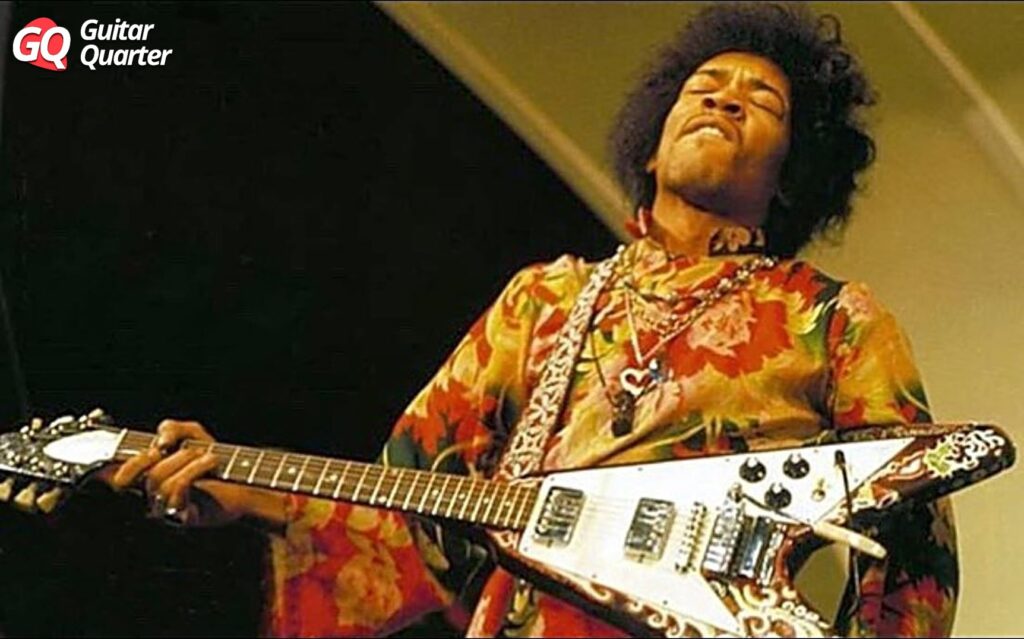
Famous Flying V Guitarists
- Jimi Hendrix
- Albert King
- Dave Davies – The Kinks
- Lenny Kravitz
- K. K. Downing – Judas Priest
- Paul Stanley
- Michael Schenker – UFO
- Lonnie Mack
- Andy Powell – Wishbone Ash
- Richie Faulkner – Judas Priest
13) Fender Jaguar
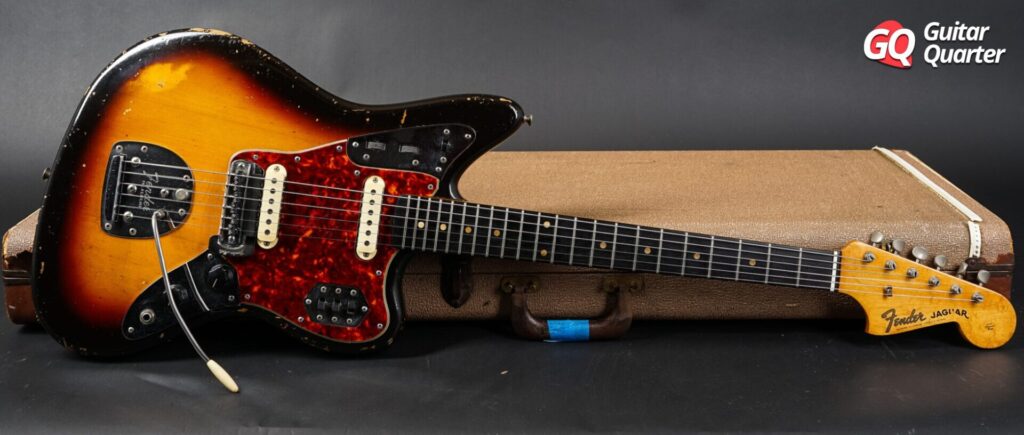
Fender released the Jaguar model in 1962, at the top of the range, being even more expensive than the Jazzmaster. The Jaguar was, together with the Jazzmaster, very famous in the “surf rock” groups of the 60’s. In the 70’s it had its decline, which forced its manufacture to be suspended in 1975. Then, it became popular again in the 90’s when it was adopted by alternative rock groups and in 1999 its manufacture was resumed.
The Fender Jaguar was based on its predecessor the Jazzmaster with a few different specifications. The main differences are the pickups, the electronics, and the scale. The Jaguar has a short 24″ scale in order to penetrate Gibson guitar users.
Regarding the electronic, this guitar has two circuits as the Jazzmaster: the Rhythm and Lead circuits. The Jaguar features two on/off switches for each of the two pickups; and a third that turns on a capacitor to filter low frequencies known as “strangle” or “Tone-cut”. The Jaguar’s rhythm circuit consists of a single slider switch on the top horn that produces a more bass-heavy neck pickup sound, with its own adjacent volume and inset tone wheels, all mounted on a chrome plate.
The Fender Jaguar pickups are single coil, tall, narrow and high output. Additionally, the pickups are surrounded by metal rings to reduce hum.
If you want more information about this guitar visit our guide on the Fender Jaguar.
Advantages of the Fender Jaguar
- Versatility of audios and use
- Ergonomic
- Short 24″ scale makes it ideal for small-handed players
Disadvantages of the Fender Jaguar
- The controls and double circuits are somewhat complex
- 24″ scale means you don’t have the classic Fender Twang
Typical Fender Jaguar Specs
- Body: Alder
- Body Type: Solid Offset
- Neck: Maple bolted to the body
- Fretboard: Rosewood or maple
- Scale: 24″
- Pickups: Two Jaguar Type Single Coils
- Electronics: The brilliant «Lead» circuit has a master volume control and a master tone control and three-position selector. The darker «Rhythm» circuit has its own volume and tone wheel control next to the circuit selector.
- Bridge: Floating bridge/anchored tailpiece with floating vibrato and locking tremolo system
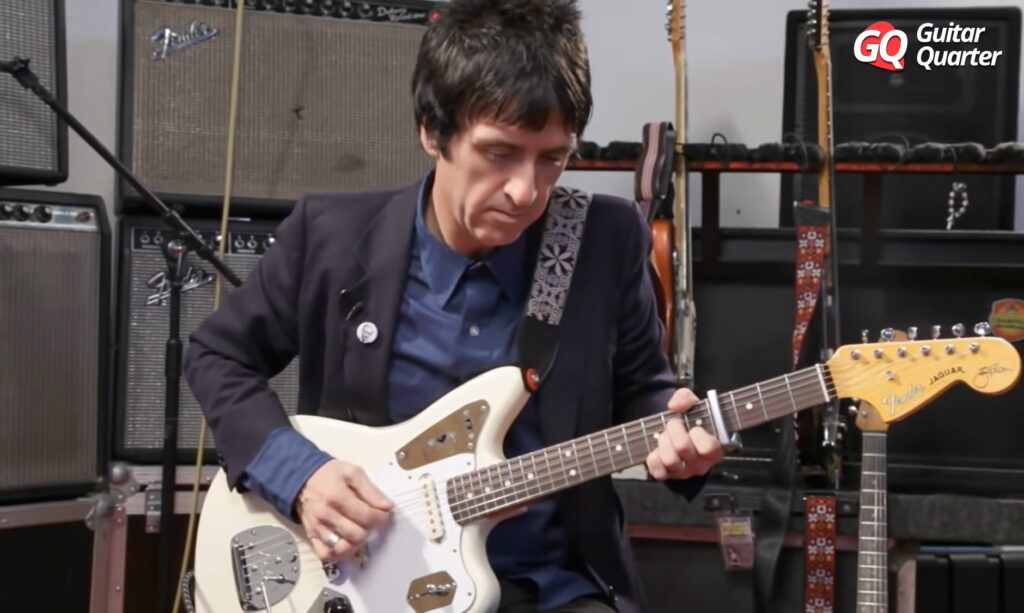
Famous Fender Jaguar Guitarists
- John Frusciante – Red Hot Chili Peppers
- Kurt Cobain – Nirvana
- Tom Verlaine – Television
- Thurston Moore – Sonic Youth
- Johnny Buckland – Coldplay
- Carl Wilson – Beach Boys
- Jeff Wooton – Gorillaz
- Johnny Marr – The Smiths, The The, Modest Mouse
- John Squire – Stone Roses
- Kevin Shields and Bilinda Butcher – My Bloody Valentine
- Billy Corgan – Smashing Pumpkins
- Graham Coxon – Blur
- Mark Gardener – Ride
- Will Sergeant – Echo & the Bunnymen
- Blixa Geld – Einfallende Neubauten, Nick Cave and the Bad Seeds
- James Johnston – Gallon Drunk, Nick Cave and the Bad Seeds
- Troy Van Leeuwen – A Perfect Circle, Queens of the Stone Age
- Win Butler – Arcade Fire
- PJ Harvey
- Brian Molko – Placebo
- Bradford Cox and Lockett Pundt – Deerhunter
14) Jackson Rhoads

The Jackson Rhoads, originally called the Concorde, was the brand’s first guitar. Grover Jackson had bought Charvell a few years earlier, when he and Randy Rhoads had designed the Concorde. Fearing that the radically different design from the Superstrats that Charvell manufactured would affect the brand, he decided to release it under the Jackson brand. However, the Jackson Rhoads was very successful and was the great beginning of the Jackson brand. Later, brands like Carvin, Ibanez, Washburn, among others, would copy the model, becoming a classic in the Heavy Metal market.
The Jackson Rhoads, whose design is inspired by the Flying V, has a “shark tail” mahogany body with a Neck-Through-Body maple neck.
Advantages of the Jackson Rhoads
- Ideal for Heavy Metal styles
- Ergonomic
- Neck-tru construction
Disadvantages of the Jackson Rhoads
- They can get heavy
- Not ideal for vintage styles
Jackson Rhoads Specs
- Body: Mahogany
- Body Type: Solid
- Mástil: Maple Neck-Through-Body
- Fretboard: Ebony and alternatively rosewood or maple
- Scale: 25.5″
- Pickups: Two Humbuckers or alternatively a single Humbucker
- Electronics: one volume control, one tone control, 3-way switch
- Bridge: Floyd Rose tremolo, Tune-o-matic String-thru
Famous Jackson Rhoads Guitarists
- Randy Rhoads – Ozzy Osbourne
- Vinnie Vincent – Kiss
- Scott Ian – Anthrax
- Alexi Laiho – Children of Bodom and Sinergy
- Roope Latvala – Children of Bodom and Synergy
- Muse’s Matt Bellamy
- Wes Borland – Limp Bizkit
- Phil Campbell – Motörhead
- Marty Friedman – Megadeth
- Kai Hansen – Gamma Ray and Helloween
- Kirk Hammett – Metallica
- Andreas Kisser – Sepultura
- Daron Malakian – System of a Down
- Mark Morton – Lamb of God
- Adrian Smith – Iron Maiden
- Dan Spitz – Anthrax
- Nigel «Nig» Swanson – The Exploited
15) Kramer Baretta

At the beginning of the 80’s the Superstrat appeared, one of the first and most emblematic was the Kramer Baretta. Kramer was the first company to offer their guitars with Floyd Rose tremolos.
The Kramer Baretta was released in 1983 and is characterized by its Floyd Rose bridge and having a single slanted humbucker pickup on the bridge position like Van Halen’s Frankenstrat. Precisely, Eddie Van Halen was an endorser of the Baretta making the guitar super popular and also the use of a single pickup in Superstrats. Thus, the Kramer Baretta became the flagship of the brand. The company’s innovation in the Superstrat market coupled with its association with Eddie Van Halen made Kramer the best-selling brand of guitars in 1985 and 1986.
Unfortunately, many poor decisions in marketing, product design, among other things, caused Kramer to go bankrupt in 1991 and production of the Baretta was discontinued. Currently, Kramer is a brand managed by Gibson. The manufacture of Kramer guitars, in charge of the Epiphone Division, has been intermittent and with a much lower quality than the original of the brand. Reissues of the Baretta have been made but of a quality that is far from the originals.
Advantages of the Kramer Baretta
- Ideal for Heavy Metal styles
- ergonomic
- The harmonics of single pickup guitars
Disadvantages of the Kramer Baretta
- Not ideal for vintage styles
- Less versatility due to having a single pickup
Kramer Baretta Specifications
- Body: Mainly Maple, and Alder
- Body Type: Solid
- Neck: Maple bolted to the body
- Fretboard: Maple
- Scale: 25.5″
- Pickups: One Slanted Humbucker in the bridge position
- Electronics: one volume control
- Bridge: Floyd Rose Tremolo
Famous Kramer Guitarists
- Eddie Van Halen
- George Lynch
- Richie Sambora – Bon Jovi
- Vivian Campbell – Def Leppard
- Reb Beach
- Satchel
- Elliot Easton
- New Snake
- Thracian Guns
16) Gibson Explorer
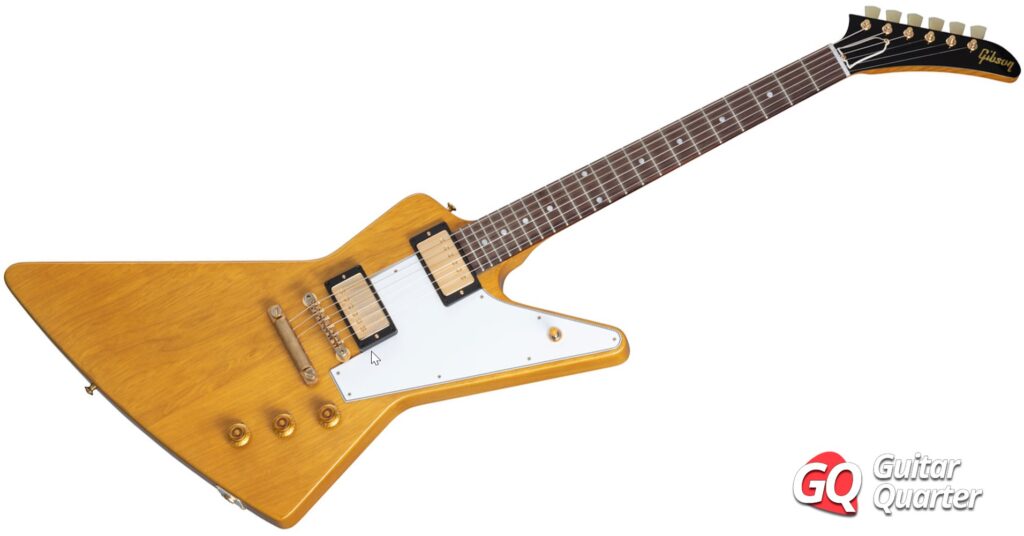
1958 was an iconic year for Gibson as it released a number of the brand’s successful models such as the ES-335 and its major siblings ES-345 and ES-355, and the futuristic Flying V and Explorer. If you want to know more visit this guide to Gibson’s Ted McCarty Era. Like the Flying V, the Gibson Explorer were part of the Modernistic Series line, both models originally using Korina as the tonewood instead of mahogany.
During 1958, a series of Korina wood Explorers of less than 100 was manufactured, some speak of 19 units, and production was suspended due to low demand. However, these guitars made from Korina are highly sought after by collectors and are some of the most expensive guitars in the world. According to the GEARanking site, they have been paid more than USD 600,000 and are one of the most expensive and collectible guitars in the world.
In 1975, Gibson resumed production of the Gibson Explorer, but using traditional mahogany as the tonewood. Like the Flying V, the Explorer is also a very copied and inspired model for Heavy Metal guitar manufacturers.
Advantages of the Gibson Explorer
- Mid and warm Gibson tone
- Unique and inspiring design for Heavy Metal styles
Disadvantages of the Gibson Explorer
- Not so versatile as other guitars
- Can be uncomfortable to play both sitting and standing
Gibson Explorer Specifications
- Body: Originally Korina, currently Mahogany
- Body Type: Solid
- Neck: Originally from Korina, currently Mahogany set-in
- Fretboard: Rosewood
- Scale: 24.75″
- Pickups: Two Humbuckers
- Electronics: two volume controls, two tone controls, 3-way switch
- Bridge: Tune-o-Matic with Stopbar tailpiece

Gibson Explorer Famous Guitarists
- Lzzy Hale
- Eric Clapton
- James Hetfield – Metallica
- The Edge – U2
- Jason Hook
- Allen Collins
- Gary Moore
- Dave Grohl – Foo Fighters
- Matthias Jabs – Scorpions
- Dave Keuning – The Killers
17) Gretsch 6120

The Gretsch 6120 guitar is synonymous with Rockabilly. However, this guitar popularized by Chet Atkins was also used by Rock, Pop and Blues guitarists such as Eric Clapton, Pete Townshend, George Harrison and John Lennon.
The Gretsch 6120 was released in 1955 with the endorsement of Chet Atkins. Rockabilly artists like Eddie Cochran and Duane Eddy quickly adopted it.
Like the White Falcon, the 6120 is a hollow body electric guitar with F-holes. But the soundboard is a bit smaller, the scale is much shorter at 24.6″ vs the 25.5″ the White Falcon. These are big differences that make both guitars similar but very different.
Do not miss our selection of the best easy Country songs for beginners to play on guitar.
Advantages of the Gretsch 6120
- Unique tone with high, mid and low frequencies
- Unique aesthetic
Disadvantages of the Gretsch 6120
- Tends to generate feedback noise
- For some guitarists it can be excessively sharp
Gretsch 6120 Specifications
- Body: Maple
- Body Type: Hollow
- Neck: Maple set-in
- Fretboard: Rosewood
- Scale: 24.6″
- Pickups: Two DeArmond Dynasonic singlecoils until 1958, then two Filter’Tron Humbuckers
- Electronics: Two volume controls and one tone control, 3-way switch
- Bridge: Space Control with Cadillac “G” tailpiece
Famous Guitarists of the Gretsch 6120
- Chet Atkins
- George Harrison – The Beatles
- John Lennon – The Beatles
- Eddie Cochran
- Duane Eddy
- Chris Cheney
- Eric Clapton
- Brian Setzer
- Reverend Horton Heat
- Pete Townshend – The Who
- Poison Ivy Rorschach
- Keith Scott
- Steve Wariner
18) Yamaha SG-2000

The Yamaha SG 2000 was released in 1976 as the Japanese brand’s top-of-the-range solid guitar. Shortly after its introduction, Yamaha hired Carlos Santana to endorse the instrument. So it was that Santana with an SG2000 appeared on the cover of the June 1978 issue of Guitar Player magazine. According to the article, Santana redesigned the model and introduced essential modifications to the model. The original prototype was the Yamaha Buda SG175 and according to Santana, the guitar was too light and didn’t resonate the way he wanted. Therefore, Carlos recommended making the guitar heavier with thicker woods and installing a brass plate under the bridge, which would later be patented as a Sustain plate.
The guitar, inspired by the Gibson Les Paul, although has its own characteristics. The Yamaha SG2000 features a three-piece mahogany/maple/mahogany neck and ebony fretboard, and T-Cross construction. The T-Cross is a construction with a neck-tru neck but on top the maple top and the Sustain plate are supported forming a T. The body of the SG2000 is mahogany with a maple top.
Advantages of the Yamaha SG-2000
- Unique deep tone
- Excellent sustain
Disadvantages of the Yamaha SG-2000
- They can be very heavy
Typical Gibson Ibanez SG-2000
- Body: Mahogany with maple top
- Body Type: Solid
- Neck: Three-piece Mahogany / Maple / Mahogany in T-Cross-Neck-tru construction
- Fretboard: Ebony
- Scale: 24.75″
- Pickups: Two Humbuckers
- Electronics: Two volume controls, 2 tone controls, 3-way switch
- Bridge: Tune-o-Matic with Sustain Plate
Famous Ibanez SG-2000 Guitarists
- Carlos Santana
- Andy Taylor – Duran Duran
- Vivian Campbell
- Bob Marley
- Phil X
- Joshua Ray – Shania Twain
- John Frusciante – Red Hot Chili Peppers
- Bernie Marsden – Whitesnake
- Phil Manazanera
- John McGeoch
We recommend our guide to the names of the guitar strings: their notes, numbers and order.
19) Ibanez JEM

The Ibanez JEM is probably the best and most iconic Superstrat of all time. Co-designed by Ibanez, Guitar Hero Steve Vai and Joe Despagni of JEM Guitars, the JEM has been in production from 1987 to the present day. This means that it has already been more than 30 years! without losing validity.
Not only is it one of the most iconic Superstrats of all time. There are several models or versions such as: JEM7, JEM77, JEM777, JEM505, JEM555, JEM333, among others. In 2020, Ibanez together with Steve Vai presented the PIA -Paradise in Art- guitar, which is seen as the evolution of the JEM or simply a premium version of the iconic guitar.
Without a doubt, its distinctive feature is the “monkey grip” on the body, which makes any guitarist immediately recognize a JEM.
Advantages of the Ibanez JEM
- Unique design
- Ergonomic and versatile
- Ideal for Shredders styles
Disadvantages of the Ibanez JEM
- Not ideal for vintage styles
- Its design is closely associated with none other than Steve Vai
Ibanez JEM Specifications
- Body: Alder or Basswood
- Body Type: Solid
- Neck: 5-Piece Maple/Walnut, Bolt-On
- Fretboard: Ebony or Rosewood or maple
- Scale: 25.5″
- Pickups: Two Humbuckers and one singlecoil in HSH configuration
- Electronics: one volume control, one tone control, 5-way switch
- Bridge: Floyd Rose Tremolo
Famous Ibanez JEM Guitarists
- Steve Vai
20) Gibson Firebird

The Gibson Firebird was released in 1963 with the goal of competing against Fender’s Jazzmaster and Jaguar. This is probably the most distinctive guitar Gibson has ever designed. Its main new features that it included is that it has a four-piece mahogany and walnut laminated neck with neck-tru construction; In addition, it had two mini Humbucker pickups with an original design, that is, they are not the same ones used by Epiphone, which would later be used in the Gibson Les Paul Deluxe. This makes the guitar brighter than other Gibsons and has great sustain.
The Firebird’s design was led by an automotive designer, Ray Dietrich, and is inspired by the Explorer with rounded curves. It also has an inverted headstock in the shape of a bird’s head.
Advantages of the Gibson Firebird
- Unique sound and design
- Lots of sustain
Disadvantages of the Gibson Firebird
- Unbalanced guitar due to very heavy neck
Gibson Firebird Specifications
- Body: Mahogany
- Body Type: Solid
- Neck: Mahogany and walnut in neck-tru construction
- Fretboard: Rosewood
- Scale: 24.75″
- Pickups: Two Firebird Mini Humbuckers
- Electronics: Two volume controls, two tone controls, 3-way switch
- Bridge: Tune-o-Matic with Stopbar tailpiece
Famous Firebird Guitarists
- Allen Collins
- Johnny Winter
- Joe Bonamassa
- Clarence “Gatemouth” Brown
- Eric Clapton
- Phil Manzanera
- Gary Moore
- Brian Jones – The Rollings Stones
- Warren Haynes
- Dave Grohl – Foo Fighters
Mentions of great guitarists of all time
It’s very hard to be fair, and while we’re happy with our pick of the 20 best electric guitars of all time, we know there are plenty of others that stand out that we could very well have included on the list.
Among other great guitars of all time worth mentioning are:
- Gretsch Duo Jet
- Ibanez RG550
- Ibanez Artist AR300
- Ibanez Musician MC500
- Ibanez Destroyer
- EVH Wolfgang
- Dean ML
- Charvel San Dimas

What is the best electric guitar of all time?
In our humble opinion, without a doubt, the best guitar of all time is the Fender Stratocaster. The Stratocaster is the best-selling guitar in the world, and the reasons are many:
- Sounds spectacular
- It is very comfortable, ergonomic
- Versatile, virtually all styles of music can be played with the right pickups.
- An unbeatable price-quality ratio
- It is the most listened to audio on popular music records of the last 70 years.
Additionally, from the Stratocaster came the Superstrat and lots of other guitar models.
But of course, this is a very personal issue. If you’re not looking to play many styles of music, and just want to play hard rock, the Les Paul or SG could become the most important electric guitar of all time. On the other hand, if you only play Country, a Telecaster may be the perfect guitar for you.
What is the best electric guitar of all time? Leave us your opinion below in the comments section.
Do not miss our new guide on musical intervals: What they are, their tables and different types.



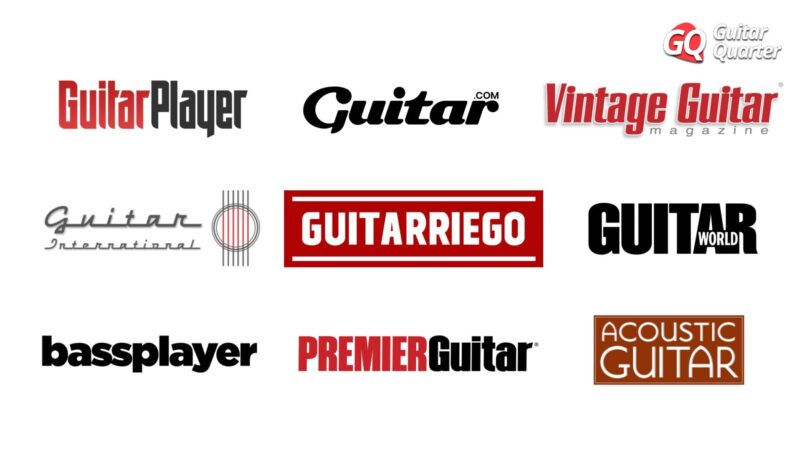


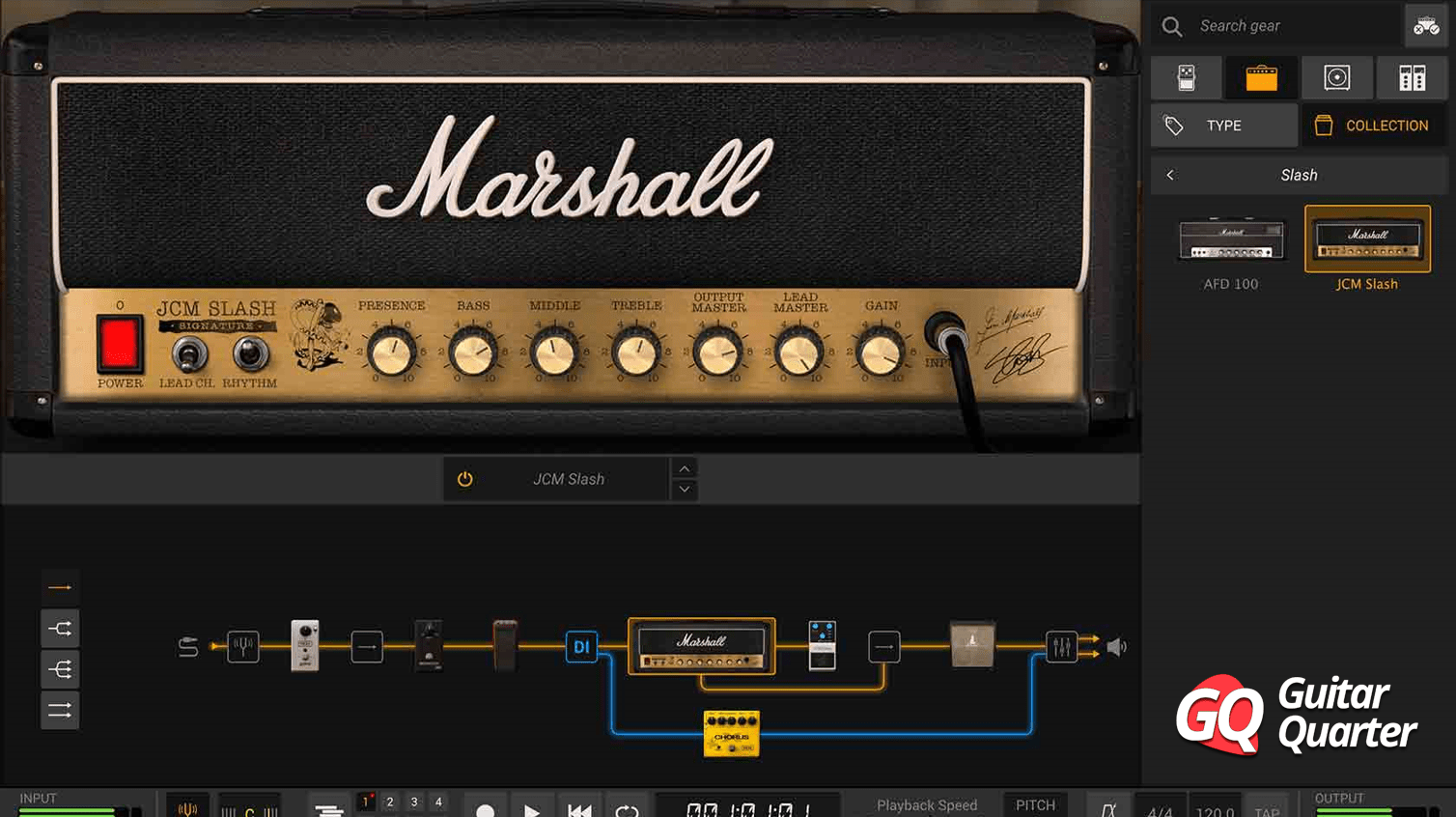
One musician overlooked as a user of the Gibson ES-335 is Justin Hayward of Moody Blues fame, he in fact still uses one now on his current tours and has used it on his recent Nights Tour.